Few things are more exciting than adding special pieces to a collection. Whether you collect artifacts, ancient coins, fossils, minerals, crystals or other antiquities from around the world, Ancient Artifacts & Treasures, Inc. has the inventory selection for you.
COLLECTING ANCIENT GLASS
by RICHARD BROCKWAY With LYNETTE MACLEOD
Ancient Glass at Ancient Artifacts and Treasures.
People think the place to see and admire ancient Roman, Greek, Egyptian or Phoenician glass is in one of the great museums. In fact, Ancient Glass is available and undervalued. A caveat: to delve into its ancient history, let alone the plunder and international intrigue, prepare to become addicted. Study in out of way places and prepare for questions: what intrigued you first, where did you find it, do you know it’s real, is it expensive, why so cheap? A 2000 year old intact unique work of art is always a wonder to people who have seen absurd prices for mass produced pottery.
I founded Ancient Art International (AAI) in 1988 after more than 20 years of studying and collecting in the ancient world. Fortunately, my corporate career allowed for much travel in Italy, France, England, Persia and Japan granting me time to visit all the museums and archaeological sites within striking distance.
When I started to do antique shows, I was unique in specializing in antiquities. People would actually ask if the items on display were for sale. Then the questions would begin. My time at these shows became almost non-stop lectures on the history and origins of the piece rather than trying to sell something. With reference books, catalogues, and museum brochures, the shows became more enjoyable, not work at all. In the process of establishing ancient art in antique shows, I used publicity to attract the antiquity aficionado who normally wouldn’t attend a conventional show. This effort of love paid off. I attracted customers for antiquities, including many who had never purchased a work of ancient art.
Since this article is intended to introduce potential collectors to the universe of collecting Ancient Glass, I will spend a little time on fundamentals. I’ve given many lectures on Ancient Glass ranging from scholarly to my basic “Collecting Ancient Glass – what to look for and what to look out for!” at glass collecting clubs, which normally don’t consider this old subject matter. A collector of, say, Tiffany, Galle’, or depression glass is a candidate for delving into Ancient Glass since so many references start chronologically with ancient Phoenician glass.
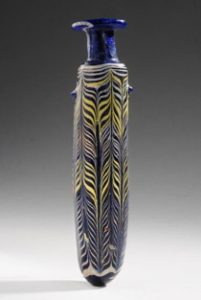
“Ancient Greek Hellenistic period c. 4th -2nd c BCE, core formed cosmetic vessel”
When developing a new interest, it’s best to read a lot, study pictures, and visit museums. Visits to reliable dealers and antique shows are especially important for “hands on” education. When it comes time to make one’s own first purchase, it’s not necessary to splurge for a masterpiece. With my first boat, I bought a good used, inexpensive example to learn with, which could be easy to unload or upgrade depending on how my interest progressed.
The importance of dealing with a “reputable” dealer! I mean one who has been in business for some time, has considerable specific experience (not antique honey pots, for example), offers an unconditional money back guaranty of authenticity in writing! In this field where authenticity and condition are everything, I recommend against the internet.
Since authenticity is primary, Ancient Glass is rewarding as discerning a real from a fake is very easy and you can become quite proficient in a relatively short time. I keep a small collection of fakes so that my customers can have a hands on lesson. Patina is most important in Ancient Glass; in the Middle East, particularly in Israel, chemicals are used to add patina to a fake. Real patina is an oxidation which we call iridescence that can only occur over a very long time (i.e. 2000 years) and is a degradation of the glass surface. It requires impurities and chemicals in the soil. In the extreme, glass would dissolve away to nothing. The ersatz patina, although pretty, is very obviously not the real thing. It looks chemical! Tiffany tried in vain to imitate ancient patina and succeeded in making attractive art objects but not close to the real glow.
Condition is extremely important in establishing value in glass collecting. Although since Ancient Glass is one of a kind, sometimes the only example in the world – such as the Portland Vase in the Boston Museum- will be repaired.
I personally stay away from any glass with repair unless it’s a rare example to flesh out my collection or I just can’t afford an intact example. It’s easy to spot repair in Ancient Glass with the use of a good light source or a blue light. A fiber optic probe is indispensable to easily spot a repair. A patch of dirt smeared on the side of a brilliant vessel is a dead giveaway.
We need to spend a little time on the history because it’s the age and story of Ancient Glass that makes it so captivating. There are many areas of beauty in art, but it is the history of the civilizations, geography and glass technology that set this area of the collecting world apart.
Objects made from glass have existed for almost 5000 years and it was certainly an accident when in the deserts of the Middle East glass was discovered. The sand, soda, silicon and other elements that compose glass exist in abundance there. Famous Roman historian Pliny the Elder (23-79 CE) wrote about glass; the following is from his Natural History, XXXXVI, 191-2:
“There is a story that once a ship belonging to some traders in nitrum put in here (the coast of Lebanon) and that they scattered along the shore to prepare a meal. Since, however, no stones for supporting their cauldrons were forthcoming, they rested them on lumps of nitrum from their cargo. When these became heated and were completely mingled with the sand on the beach, a strange liquid flowed in streams; and this it is said, was the origin of glass.” I certainly hate to disagree with as esteemed an historian as Pliny, but it has been prove that the discovery of glass goes back much earlier than the Phoenicians in the 1 Millenium BCE. It’s now acknowledged that glassmaking was discovered in Mesopotamia, (meaning literally “in the middle of the rivers”, the Tigris and Euphrates) in the 3rd Millenium BCE, probably in modern day Iraq and northern Syria. It’s believed that perhaps the earliest example of glass may have been faience, a beautiful glaze (usually blue or turquoise) which forms when a paste of sand/silica is fired at high temperatures. By 2500 BCE, beads and amulets, jars, vessels and small statues were made. These beads can be made into very wearable contemporary necklaces.
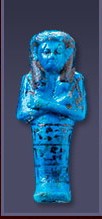
“Blue faience Egyptian Ushabti, 18 Dynasty, c. 1539-1292 BCE”
Glassmaking in ancient Mesopotamia evolved into both well documented science and high ritual. Ancient clay tablets were inscribed with chemical composition and fabrication techniques and dictates for choosing the most propitious day, sun, stars, sheep sacrifices and incense. Those who approached the kiln had to be “ritually” clean. 4000 year old tablets actually record our current chemical composition of glass.

“Babylonian Clay Cuneiform Tablet, Mesopotamian. c.1500 BCE ”
The earliest actual glass vessel fragments (c.1500-1400 BCE) were found in Mesopotamia. Glass was accessible only to the very wealthy or nobility during these early eras because of its labor intensity and rarity. It was used in jewelry and decorations, cylinder seals and vessels. The wealthy ladies especially liked to use it for their unguents and cosmetics. Glass also was a wonderful imitation for other more precious materials such as rare stones – lapis, banded onyx, crystal and red agate. Glass vessels for beer and wine suddenly appeared in the mid 2 Mill.BCE.
In approximately 1500 BCE the great Eyptian Pharaoh Tutmosis III extended his rule to Syria and Mesopotamia. Tut captured the glass craftsmen, enslaved and transported them to Alexandria. With the advent of Egypt’s major glass industry, a new technique was developed called “core formed” or “sand core” – very beautiful and labor intensive. Almost always the first photograph in a glass history or reference book will be of a core formed glass vessel. The sand core technique resulted in brilliant multi-hued, small cosmetic vessels with the multi colored filaments wrapped around the glass core and then combed into the delicate feather pattern.
Incidentally, for years the literature has called these sand core glass vessels Phoenician because the Phoenicians were the brave seafaring traders of the 1st mill BC who plied the waters of the Mediterranean Sea with their wares, of which the most distinctive and sought after were these vessels for the rich – a very high value cargo to be sure!
After a period of decline from 1500-900 BCE and then revival under the Egyptians and Greeks, employing much the same technology, a major technological breakthrough occurred some time around 50 BCE with the invention of glass blowing. This ranks with the all time great historical technical discoveries because suddenly from “one of a kind” art objects taking weeks to make, glass vessels could be blown quickly. The uses and diversities of shape multiply and the cost dropped dramatically. Glass remained a major art form as beautiful vessels could be blown into moulds taking the shapes of heads, faces, fruit and animals adorned with inscriptions, signatures, and more. When collecting any of these, look for embellishments which make an Ancient Glass vessel many times more important.
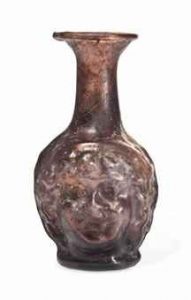
“Rare large mould blown Janus Head Sprinkler Flask c. 1 – 3rd CE”
The site of the original glass blowing factory is unknown (several have been excavated) but it was somewhere in today’s Syria, Lebanon, Israel or Egypt. All claim the invention of the glass blowpipe and the original factory. During the reign of the Roman Emperor Augustus (circa 63-14 BCE) glassmakers were forcibly abducted (again! – these guys were in great demand) from Egypt and Syria to Italy, establishing glassmaking as an industry rather than objects only for the rich. The world famous Murano in Italy began due to the early efforts of Emperor Augustus, although the evolution is a bit hazy. Interestingly, one pays more today for modern Murano rip-offs than for an authentic piece of ancient glass.
Glassmaking spread rapidly during the period 1st -3rd c. CE into England, France, Germany & Spain. Roman period glass has even been found in China dating to the Han Dynasty, but is thought to have been shipped there on the backs of camels over the Silk Route, not “Made in China” as everything is today! The Ancient Glass from the Rhine Valley is unique and highly collectable, but unusually expensive due to the appetite of affluent German collectors. It is very decorative and colorful, almost ornate!
Glassmaking in approximately 5th .C. CE tended to decline a bit after the high Roman Period. A flowering in the Islamic world (starting approx 8 C. CE) resulted in another era of distinctive Ancient Glass, A collector could concentrate strictly on Islamic glass, but the price rise in oil created an immense amount of wealth in the Middle East which led to a bubble in Islamic Art, including glass.
One appealing aspect of Ancient Glass that was once the rare province of the most wealthy ruling classes now is accessible to the “income challenged” modern day collector. One can buy a perfect piece of Ancient Glass for around $100. The photo shows an absolutely authentic piece of Ancient Glass for $350.
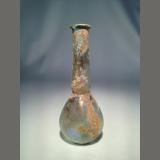
“Roman Blown Glass Unguentarium, c. 1st -3rd C. CE”
To conclude this little ramble, it should be emphasized that Ancient Glass is not esoteric or out of reach, but rather a very undervalued and easily attainable way to acquire a museum quality collection. I’ve met many who acquire with the ultimate goal of donation to an institution at a greatly inflated price, thus attaining fame, respect and a sizable tax deduction! Just beware of provenance if this is your desire.
As to appreciation, no less an authority on investing than Forbes Magazine, which runs an” investing in art” column lauded Ancient Glass in the Sept.13, 1993 issue. This all time favorite of mine featured Tiffany’s high prices. Louis Comfort Tiffany collected in the late 1800’s and was influenced by Ancient Glass, notably Roman. The article goes into the values of collecting ancient Greek, Roman, Egyptian and Phoenician glass. I love to tease my modern glass collecting dealers and friends with the punchline from the Forbes article: “Why collect Tiffany when you can collect the real thing, ancient glass, at much lower cost and with a much greater chance of appreciation.” In my long collecting and investing life, of all the areas that I’ve invested, Ancient Art is the only segment that has consistently gone up and never gone down. After all, “they aren’t making any more of it!”
By: Richard Brockway and Lynette MacLeod, President and Vice President respectively of Ancient Art International. (AAI), Vero Beach, Florida. AAI specializes in Ancient Fine Art incl. Greek, Roman, Egyptian, Middle Eastern, Gandharan, Chinese, and Islamic antiquities. They are sold with an unconditional money back guarantee of authenticity and with a Certificate of Authenticity.
Photography for the Richard Brockway Collection of Art by Frank Miller for an exhibit at the Hallie Ford Museum of Art, Willamette University.

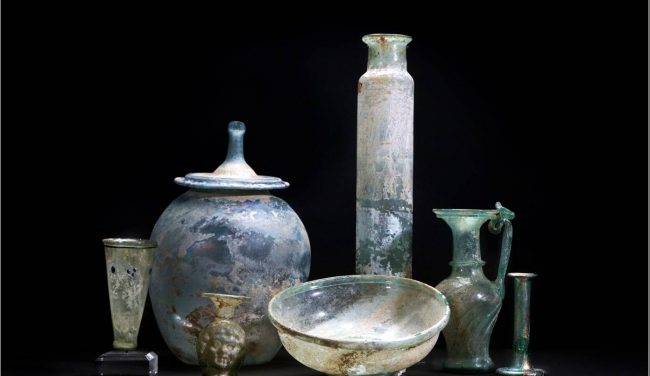


Comments are closed.